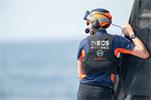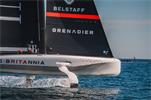Renishaw brings AM expertise to INEOS Britannia America’s Cup team
September 2024
See the full case study here
The America's Cup is the world's oldest international sports trophy — and Britain has never won. In 1851, the US took home the Cup and since then, sailing teams from across the globe have competed in the challenging event. INEOS Britannia, which was formed in 2018, will head to Barcelona for the 37th America's Cup in August, 2024. In September, the team will compete in the Challenger Selection Series, where challenging teams compete to determine who will face the defending Emirates Team New Zealand in the final match in October 2024.
Global engineering company, Renishaw, is the official precision measurement and additive manufacturing (AM) partner for INEOS Britannia. The company helped to optimise the design and manufacture of parts for the team's prototype and final boats, as well as supplying products and expertise in position encoders, which can provide digital position feedback to improve the boat's performance.
Background
This is the third consecutive challenge for the racing team led by Sir Ben Ainslie, winner of five Olympic medals and the most successful sailor in Olympic history. Ainslie leads the first British team to have three consecutive challenges since Sir Thomas Lipton and his team over one hundred years ago. Renishaw has been a partner for all three of these challenges.
The America's Cup will see all teams using advanced racing yachts, AC75s. Equipped with some of the best of British technology, the 75-foot foiling monohull ‘Britannia' will be able to reach speeds of up to 50 knots — over 60 miles per hour. Ahead of the competition, the team also developed parts for a 28-foot test boat, ‘T5', and a full-sized prototype boat, ‘RB1', using a range of sustainable materials and processes.
“The America's Cup is a design and engineering competition as much as it is a race — we cannot build a winning boat using off-the-shelf components,” explained Michel Marie, Manufacturing Manager at INEOS Britannia. “Building bespoke parts, such as the unique runner beam fitting and outhaul sheave box, demonstrates our engineering expertise, as well as making drastic improvements to the boat.”
“Producing bespoke parts, such as the foil wings and rudder, from carbon fibre and other advanced materials using cutting-edge manufacturing processes enables the boat to handle harsher environments, reduce its weight and improve its performance,” continued Marie. “Additive manufacturing is therefore a key technology for us.”
Challenge
INEOS Britannia was tasked with constructing a bespoke, high-performance boat within a determined budget and timeframe. Critical components, such as the boat's runner, flap fairings, bowsprit and outhaul sheave box, will all influence speed, efficiency and other performance factors.
The weight of the 7,800 kg racing yacht, for example, is supported by underwater hydrofoils that change shape as the yacht's speed varies; improving the performance of these foils can give a speed advantage. However, speed also creates drag, so the foils have flaps that can rotate and extend to make the foil more hydrodynamic. Flap fairings cover any gap between the hydrofoil wing and flap, and these components must be strong and have to meet tight geometrical tolerances to support the hydrofoil.
The runner, a rigging element that runs from the back of the boat to the top of the rig, is integral to the boat's performance, both structurally and to control the shape of the mast and sails. The outhaul sheave box houses the mechanics of the many boom systems on the yacht, used to control the main sails when foils fill with air. This component had to be an optimum shape and weight to fit the components without taking up too much space, which could not be made using traditional manufacturing methods.
“During the development of our prototype boat, the RB1, the team identified a specific structural load case on the bowsprit, a spar running out of the front of the boat, where the headsail can be attached to achieve more power and speed when travelling away from the wind,” explained Marie. “We felt that prototyping a bowsprit end detail to provide additional strength would be a worthwhile exercise.”
“The part was an obvious candidate for additive manufacturing, due to the method's ability to produce components rapidly and precisely,” explained Chay Allen, AM Customer Applications Manager at Renishaw. “However, in the initial design, the number of overhangs in the part was a challenge. Parts with overhanging features, where the machine must add melt material over unfused powder, requires sacrificial support structures for the build to be successful, increasing build time and post processing.”
Solution
To build these integral components effectively, the INEOS Britannia team stayed in close communication with Renishaw to share expertise and collaborate on the final design.
Introducing design for additive manufacture (DfAM) at the early stages meant that overall part geometry of all these components was well suited to the AM process. When designing the bowsprit, for example, Renishaw overcame the issue of overhangs by changing the orientation of the part on the build plate and only built supports in critical areas. Effective engineering was crucial to designing all these components for AM production to achieve the complex geometries required without adding any residual stress during printing or adding weight that reduces performance.
“We liaised with the designers at INEOS Britannia to ensure the final parts had all the properties required,” stated Ben Snell, Applications Engineer at Renishaw. “For example, the team explained that they wanted to machine the runner beam end-fitting once it was built, so the design required extra material to clamp it securely, so we added 22 mm of stock to the design.”
“We also looked at any areas of the part where stress might concentrate during the build, for example inside the cylinder of the part,” added Snell. “To prevent stress from distorting the build we suggested adding a right-angle diameter to the cylinder to improve its integrity.”
In other cases, Renishaw designed optimised supports to anchor parts and prevent build failure. When developing the foil flap fairings, for example, the team added T-shaped supports to stiffen the structure and prevent distortion. The supports were designed to taper, reaching a thickness of 0.3 mm when in contact with the part, which enabled easy snap-off removal. Similarly, the design of the outhaul sheave box featured ten-millimetre diameter support pillars to prevent the stress of the melting process causing the part to peel up from the plate.
All parts were built on the RenAM 500Q metal AM system using titanium Ti6Al4V ELI-406 metal powder, a material that offers high corrosion resistance and has a good strength-to-weight ratio. The RenAM 500Q system contains four 500 W lasers that are able to access the entire powder bed simultaneously, improving productivity and lowering cost per part. The system also features automated powder and waste handling systems that enable consistent process quality, improve safety and reduce operator intervention.
Results
All the parts were manufactured with Renishaw's support, with the outhaul sheave box taking 50 hours and 45 minutes to build. The bowsprit end detail took 18 hours and 39 minutes, and the runner beam end-fitting took 18 hours and 23 minutes to build. By using additive manufacturing process monitoring (AMPM) during these builds, Renishaw was able to monitor each build layer-by-layer to ensure quality and accuracy. Using this software also enabled the engineers to help INEOS Britannia closely analyse the process, increase its understanding of build quality and ensure the final parts met expectations before post processing.
“The partnership with Renishaw taught us how to adapt designs to make our final parts better suited to the AM process,” explained Nye Davis, Procurement Project Engineer at INEOS Britannia. “The most important lesson that our engineering team learnt from the project is to consider the processes and time required to take a design from a CAD file to a finished product. The capabilities of the Renishaw team to add structural supports and process the printed part to our requirements ensured the success of this project.”
“Our team regularly works with Renishaw because its engineers are always responsive to our requirements and collaborate with our engineers at every stage of the design and manufacture of each project. Once again, it has produced a high quality AM part to contribute to our America's Cup challenge. This collaboration also reinforces the capabilities of additive manufacturing as a high-quality, production manufacturing technique, for high-technology applications such as ours,” concluded Davis.
“Renishaw has been proud to contribute its expertise to INEOS Britannia for many years,” said Finlay Evans, Principal Design Engineer for Renishaw. “We're really excited to continue our relationship with the team and its challenge for the America's Cup in 2024, and to be able to give support in the UK and Spain. From our AM Solutions Centre in Barcelona, we can provide a rapid response should the team need additional support with additive manufacturing components once racing has started.”
INEOS Britannia tested its boat at the preliminary regatta races in Vilanova, Spain and Jeddah, Saudi Arabia. Now, the team will head to Barcelona to use the boat in the first of the Challenger Series.
For further information, visit www.renishaw.com/am
Downloads
- Case study: Renishaw brings AM expertise to INEOS Britannia America’s Cup team [111kB]
-
 INEOS Britannia
[2048 x 1365]
[1.5MB]
INEOS Britannia
[2048 x 1365]
[1.5MB]
-
 INEOS Britannia
[2048 x 1365]
[1.8MB]
INEOS Britannia
[2048 x 1365]
[1.8MB]
For further images, videos, company biographies or information on Renishaw and its products, visit our Media Hub.

